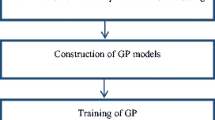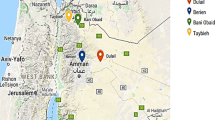Abstract
Despite the extensive use of constructed wetland (CW) as an effective method for domestic wastewater treatment, there is lack of clarity in arriving at well-defined design guidelines. This is particularly due to the fact that the design of CW is dependent on many inter-connected parameters which interact in a complex manner. Consequently, different researchers in the past have tried to address different aspects of this complexity. In this study, an attempt is made to model the influence of relative humidity (RH) in the effectiveness of BOD5 removal. Since it is an accepted fact that plants respond to change in humidity, it is necessary to take this parameter into consideration particularly when the CW is to be designed involving changes in relative humidity over a shorter time horizon (say a couple of months). This study reveals that BOD5out depends on the ratio of BOD5in and relative humidity. An attempt is also made to model the outlet BOD5 using genetic programming with inlet BOD5 and relative humidity as input parameters.





Similar content being viewed by others
References
Akratos, C. S., Papaspyros, J. N. E., & Tsihrintzis, V. A. (2008). An artificial neural network model and design equations for BOD and COD removal prediction in horizontal subsurface flow constructed wetlands. Chemical Engineering Journal, 143, 96–110.
Ayaz, S. C. (2008). Post treatment and reuse of tertiary treated waste water by constructed wetlands. Desalination, 226, 249–255.
Babatunde, A. O., Zhao, Y. Q., & Zhao, X. H. (2010). Alum sludge based constructed wetland system for enhanced removal of P and OM from waste water: concept, design and performance analysis. Bioresource Technology, 101, 6576–6579.
Bastviken, S. K., Weisner, S. E. B., Thiere, G., Svensson, J. M., Ehde, P. M., & Tonderski, K. S. (2009). Effects of vegetation and hydraulic load on seasonal nitrate removal in treatment wetlands. Ecological Engineering, 35, 946–952.
Brix, H. (1994). Constructed wetlands for municipal wastewater treatment in Europe. In W. J. Mitsch (Ed.), Global wetlands: old world & new (pp. 325–333). Amsterdam: Elsevier [Chapter 20].
Calheiros, C. S. C., Rangel, A. O. S. S., & Castro, P. M. L. (2007). Constructed wetland systems vegetated with different plants to the treatment of tannery waste water. Water Research, 41, 1790–1798.
Chang, J., Zhang, X., Perfler, R., Xu, Q.-S., Niu, X.-Y., & Ge, Y. (2007). Effect of hydraulic loading rate on the removal efficiency in a constructed wetland in subtropical China. Fresenius Environmental Bulletin, 16(9), 1082–1086.
Christopher, O., Akinbile, M. S., Yusoff, A. Z., & Ahmad, Z. (2012). Landfill leachate treatment using subsurface flow constructed wetland by Cyperushaspan. Waste Management, 32, 1387–1393.
Griffin, D. M. J., Bhattarai, R. R., & Xiang, H. (1999). The effect of temperature of biochemical oxygen demand removal in a subsurface flow wetland. Water Environment Research, 71(4), 475–482.
Karathanasis, A. D., Potter, C. L., & Coyne, M. S. (2003). Vegetation effects on fecal bacteria, BOD, and suspended solid removal in constructed wetlands treating domestic wastewater. Ecological Engineering, 20, 157–169.
Knight, R.L., Ruble, R., Kadlec, R.H., & Reed, S. (1993). North American Treatment Wetland Database-electronic database created for the US Environmental Protection Agency.
Koza, J. R. (1992). Genetic programming: on the programming of computers by natural selection. Cambridge, MA: MIT Press.
Langergraber, G. (2008). Modeling of processes in subsurface flow constructed wetlands: a review. Vadose Zone Journal, 7(2), 830–842.
Mina, A.P. I., Costa, M., Matos, A., & Sousa Coutinho, C. (2011). Polishing domestic water on a subsurface constructed wetland: organic matter removal and microbial monitoring. International Journal of Phytoremediation, 13, 947–958.
Pan, J., Zhang, H., & Ke, W. L. F. (2012). Full scale experiment on domestic wastewater treatment by combining artificial aeration vertical and horizontal flow constructed wetland system. Water Air Soil Pollution, 223, 5673–5683.
Park, S., Bae, H., & Kim, C. (2008). Decision model for coagulant dosage using genetic programming and multivariate statistical analysis for coagulation/flocculation at water treatment process. Korean Journal of Chemical Engineering, 25(6), 1372–1376.
Villar, P. M., Dominguez, E. R., Tack, F., Ruiz, H., Sanchez Morales, R., & Arteaga, L. E. (2012). Vertical subsurface wetland for waste water purification. Procedia Engineering, 42, 1960–1968.
Priya, A., Avishek, K., & Pathak, G. (2012). Assessing the potentials of Lemna minor in the treatment of domestic wastewater at pilot scale. Environmental Monitoring and Assessment, 184, 4301–4307.
Rai, U. N., Tripathi, R. D., Singh, N. K., Upadhyay, A. K., Dwivedi, S., Shukla, M. K., Mallick, S., Singh, S. N., & Nautiyal, C. S. (2013). Constructed wetland as an ecotechnological tool for pollution treatment for conservation of Ganga river. Bioresource Technology, 148, 535–541.
Reed, S. C., & Brown, D. (1995). Subsurface flow wetlands—a performance evaluation. Water Environment research, 67(2), 244–248.
Rousseau, D., Geenens, D., Vanrolleghem, P. A & Pauw, N.D. (2002). Short-term behaviour of constructed reed beds: pilot plant experiments under different temperature conditions. In: Proceedings of the 8th International Conference on Wetlands Systems for Water Pollution Control. Arusha, Tanzania, September 16–19, 128–139.
Shelef, O., Gross, A., & Rachmilevitch, S. (2013). Role of plants in a constructed wetland: current and new perspectives. Water, 5(2), 405–419.
Shutes, R. B. E. (2001). Artificial wetlands and water quality improvement. Environment International, 26, 441–447.
Sivapragasam, C., Muttil, N., Arun, V. M., & Jeyasudha, S. (2012). Suitability of universal function approximators in redesigning rainguage network for a river basin. International Journal of Engineering and Earth Sciences, 5(2), 255–267.
Sivapragasam, C., Muttil, N., Catherin Jeselia, M., & Visweshwaran, S. (2015). Infilling of rainfall information using genetic programming. Aquatic Procedia, 4, 1016–1022.
Sivapragasam, C., Muttil, N., Muthukumar, S., & Arun, V. M. (2010). Prediction of algal blooms using genetic programming. Marine Pollution Bulletin, 60, 1849–1855.
Solano, M. L., Soriano, P., & Ciria, M. P. (2004). Constucted wetland as a sustainable solution for wastewater treatment in small villages. Biosystems Engineering, 87(1), 109–118.
Steer, D., Fraser, L., Boddy, J., & Seibert, B. (2002). Efficiency of small constructed wetland for subsurface treatment of single-family domestic effluent. Ecological Engineering, 18, 429–440.
Stottmeister, U., Wiener, A., Kuschk, P., Kappelmeyer, U., Kastner, M., Bederski, O., Muller, R. A., & Moormann, H. (2003). Effects of plants and microorganisms in constructed wetlands for wastewater treatment. Biotechnology Advances, 22, 93–117.
Tomenkoa, V., Ahmedb, S., & Popova, V. (2007). Modelling constructed wetland treatment system performance. Ecological Modeling, 205, 355–364.
Trang, N. T. D., Konnerup, D., Schierup, H. H., & HuuChiem, N. (2010). Kinetics of pollutant removal from domestic waste water in a trophical horizontal subsurface flow constructed wetland system effect of hydraulic loading rate. Ecological Engineering, 36(4), 527–535.
Vymazal, J. (1988). Czech constructed wetlands database. Ecology and Use of Wetlands: Prague, Czech Republic [in Czech].
Vymazal, J., & Kropfelova, L. (2011). A three stage experimental constructed wetland for treatment of domestic sewage: first 2 years of operation. Ecological Engineering, 37, 90–98.
Wu, H., Zhang, J., Ngo, H. H., Guo, W., Hu, Z., Liang, S., Fan, J., & Liu, H. (2015). A review on the sustainability of constructed wetlands for waste water treatment: design and operation. Bioresource Technology, 175, 594–601.
Yalcuk, A. (2013). Modeling of different types of constructed wetlands for removing phenol from olive mill waste water using an artificial neural network. Ekoloji, 22(88), 28–35.
Zhang, L. Y., Zhang, L., Liu, Y. D., Shen, Y. W., Liu, H., & Xiong, Y. (2010). Effect of limited artificial aeration on constructed wetland treatment of domestic wastewater. Desalination, 250, 915–920.
Author information
Authors and Affiliations
Corresponding author
Rights and permissions
About this article
Cite this article
Sankararajan, V., Neelakandhan, N. & Chandrasekaran, S. Modeling of constructed wetland performance in BOD5 removal for domestic wastewater under changes in relative humidity using genetic programming. Environ Monit Assess 189, 164 (2017). https://doi.org/10.1007/s10661-017-5857-y
Received:
Accepted:
Published:
DOI: https://doi.org/10.1007/s10661-017-5857-y




